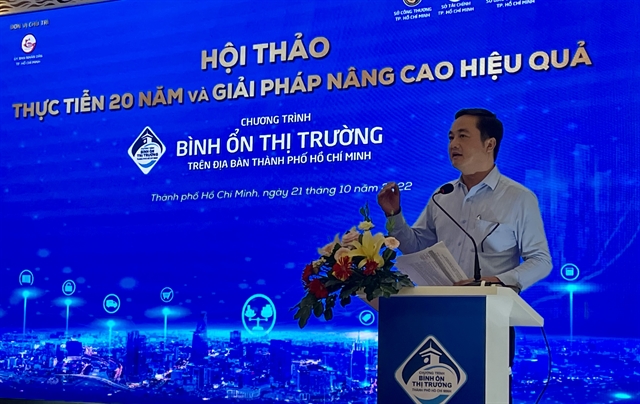 Economy
Economy


|
| Bùi Tá Hoàng Vũ, director of the city’s Department of Industry and Trade, speaks at a conference on Friday to review the market stabilisation programme over the last 20 years. VNS Photo Thu Hằng |
HCM CITY — The HCM City's market stabilisation programme has provided a stable and abundant supply of goods with guaranteed quality at reasonable prices distributed through an extensive retail distribution system in the past 20 years, authorities and enterprises said.
As an economic hub, HCM City has attracted migrant workers from other cities and provinces, putting pressure on the city Government to ensure social welfare for city residents and migrant people as well, said Phan Thị Thắng, deputy chairwoman of the city People’s Committee.
The market stabilisation programme, which has been implemented since 2002, is the city’s innovative solution to ensure social welfare, Thắng said at a conference to review the market stabilisation programme over the last 20 years held on Friday.
The programme is aimed at stabilising essential goods with prices always lower than the general market, with coordination between State management agencies, including the Department of Industry and Trade, the Department of Finance, and key manufacturing, trading and distribution enterprises.
Lý Kim Chi, chairwoman of the HCM City Food and Foodstuff Association, said more traditional markets should be selected to participate in the market stabilisation programme.
State agencies need to draw participation of the entire supply chain from raw materials, farming, planting, processing, production, transportation and distribution to enhance the effectiveness of the programme.
Yostsawet Srisutiwong, director of finance and administration at MM Mega Market Vietnam, said, “for many years, MM Mega Market has been closely monitoring the market stabilisation programme, realising that this is a strategic programme to maintain market stability, especially after many fluctuations during the COVID-19 epidemic.”
“The programme’s criteria are also consistent with our vision and orientation in Việt Nam,” he said.
In 2022, MM Mega Market officially became one of 69 businesses in the programme.
The unstable supply of input materials, the decline in global purchasing power due to high inflation in important import markets, and tight consumer spending are the main challenges that enterprises are facing and need to overcome.
It is important to welcome the participation of manufacturers in every city and province nationwide. However, currently, the programme mainly includes enterprises in HCM City and only a few enterprises come from other provinces and cities.
The increasing number of enterprises in the programme and the favourable conditions for businesses in other provinces and cities to jointly implement stabilisation not only spread the impact of stabilisation quickly and strongly, but also control inflation and ensure social welfare in a broader context, Srisutiwong said.
With the significant change in consumer behaviour post COVID-19, the programme needs to consider to ask all e-commerce players to participate and consider to build an e-commerce trading floor for its programme.
Bùi Tá Hoàng Vũ, director of the city’s Department of Industry and Trade, said since 2010, the programme has been implemented throughout the year, not just for Tết (Lunar New Year) holiday.
Over the 20 years of its implementation, the programme of market stabilisation has attracted 69 businesses and 12 credit institutions.
Most large distribution systems have joined in the programme, including Saigon Coop, Bách Hoá Xanh, MM Mega Market, Central Retail, Satra, Aeon Citimart, and GS25. —VNS




